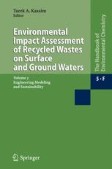Search
Search Results
-
Nonaqueous Phase Liquid Pool Dissolution in Subsurface Formations
The objective of this chapter is to present some recent developments on nonaqueous phase liquid (NAPL) pool dissolution in water saturated subsurface...
-
Advancing “Autonomous” sensing and prediction of the subsurface environment: a review and exploration of the challenges for soil and groundwater contamination
Can we hope for autonomous (self-contained in situ) sensing of subsurface soil and groundwater pollutants to satisfy relevant regulatory criteria?...

-
Experimental Assessment and Modeling of Enhanced Solubilization of Pool-dominated Tetrachloroethene Source Zone in Heterogeneous Porous Media
The purpose of this study is to investigate the elution behavior of pool-dominated dense nonaqueous phase liquid (DNAPL) source zone mass during...

-
Free Product Recovery of Non-aqueous Phase Liquids in Contaminated Sites: Theory and Case Studies
Organic liquids with low water solubility are generally described as Non-Aqueous Phase Liquids (NAPLs). They penetrate the soil subsurface as oily...
-
Characterization and Partitioning Behavior of Creosote in Different Matrices: Soil, Water, and Air
Creosote is a multicomponent oil classified as a dense non-aqueous phase liquid (DNAPL) produced from coal tar distillation. The concept of phase...

-
Biosurfactants and chemotaxis interplay in microbial consortium-based hydrocarbons degradation
Hydrocarbons are routinely detected at low concentrations, despite the degrading metabolic potential of ubiquitous microorganisms. The potential...

-
Moving into the Third Decade of Nanoscale Zero-Valent Iron (NZVI) Development: Best Practices for Field Implementation
This chapter provides an overview of environmental restoration efforts involving the application of NZVI. The chapter focuses on the novel...
-
Experimental Investigation and Numerical Modeling of Enhanced DNAPL Solubilization in Saturated Porous Media
The accidental release of organic contaminants in the form of non-aqueous phase liquids (NAPLs) into the subsurface is a widespread and challenging...

-
Intermediate-Scale Investigation of Enhanced-Solubilization Agents on the Dissolution and Removal of a Multicomponent Dense Nonaqueous Phase Liquid (DNAPL) Source
The presence of multicomponent nonaqueous phase liquid (NAPL) source zones in the subsurface can significantly complicate remediation efforts,...

-
Multimedia environmental analysis of PCBs fate and transport mechanism through a case study of transformer oil leakage
Transformer oil leakage having large quantity of PCBs is one of the most deplorable incidents resulting in huge negative impacts on the environment....

-
Modeling Systems and Processes in Wetlands: A Case Study of Engineered Bioremediation of BTEX-Contaminated Water in Treatment Wetlands
A number of pollutants are released to the soil-water systems due to various anthropogenic activities. One of the most environmentally benign...
-
Partitioning of Aromatic Constituents into Water from Jet Fuels
A comprehensive study of the most commonly used jet fuels (i.e., Jet A-1 and JP-8) was performed to properly assess potential contamination of the...

-
Design of optimal groundwater remediation systems under flexible environmental-standard constraints
In develo** optimal groundwater remediation strategies, limited effort has been exerted to solve the uncertainty in environmental quality...

-
A predictive method for crude oil volatile organic compounds emission from soil: evaporation and diffusion behavior investigation of binary gas mixtures
Due to their mobility and toxicity, crude oil volatile organic compounds (VOCs) are representative components for oil pipeline contaminated sites...

-
DNAPL Source Zone Characterization and Delineation
The ability to remediate a chlorinated solvent source zone depends greatly on the adequacy of source zone characterization. In general, chlorinated...
-
Flux-Based Site Assessment and Management
Although characterizing dense nonaqueous phase liquid (DNAPL) source zones poses significant challenges, there have been several recent improvements...
-
Mass Transfer Characteristics of Nonaqueous Phase Liquid Based on Air–Liquid Interfacial Area in Variably Saturated Porous Media
Vapor phase mass transfer is an important interphase transport process that dominates the overall transport phenomena in liquid–gas system in porous...

-
In Situ Thermal Treatment of Chlorinated Solvent Source Zones
Combining in situ heating with physical recovery, chemical reaction and biodegradation processes has led to a spectrum of in situ thermal remediation...
-
Groundwater Remediation and the Use of Alternative Endpoints at Highly Complex Sites
Some contaminated sites (including many of those with chlorinated solvent source zones) can be so complex that restoration in a reasonable time frame...
-
Modeling Source Zone Remediation
Significant advances have produced source zone remediation modeling tools of real practical value. These advances include improved understanding of...
